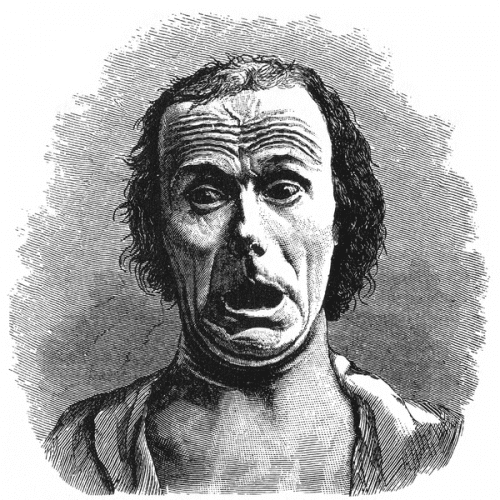A rare disease makes people fearless, it is possible to scare them in laboratory conditions, but they are still unable to learn from experience

"Look at her." I whispered to Ilan. "Drives in the front seat, leads us wherever she wants. Authoritative, smart, and I think I even saw her once at some conference of the Israeli police, holding a copy of Scientific American-Israel in her hand. She is absolutely perfect for you."
"And beautiful too." Ilan said, matter-of-fact as always. He tried to get away from me a little, in the back seat, but the handcuffs got in the way.
"Yeah, that too," I waved the comment away. "And you've already managed to convince her to take us in her car. Why don't you start with you?"
He hesitated a moment. I watched him intently. A muscle in his cheeks began to vibrate wildly. "I… I'm scared." admitted "I have a feeling that when she stopped us, I didn't leave a good impression on her. Do you remember she thought I was drunk, just because of the smell? And all because ethanol was spilled on my clothes in the lab."
Credit: Daphne Axel
"Yes, but don't worry. At the station they will check your blood alcohol concentration and see that you are fine. And besides, everyone gets scared from time to time." I said Then I came back. "Except for people with Auerbach-Wyatt disease. But you are very lucky that you are not one of them."
"Orbach what?" Ask.
"Auerbach-Wyatt Disease." I repeated myself. "This is a rare genetic disease, which affects an area of the brain called the the amygdala. The amygdala regulates emotion, and is mainly responsible for the feeling of fear and awe. The disease causes parts of the amygdala to wither and die, and the result is that some of those people are unable to feel fear. You can bring snakes close to them, show them scary movies, take them to haunted houses - and they still won't bat an eyelid."
"Make them start with beautiful women?" Ilan suggested with a pale smile. The lady glanced back with piercing eyes. Ilan lowered his eyes. After a moment she returned her eyes to the road.
"It's okay, she didn't hear. She just wanted to look at you." I whispered to him. "And anyway, they didn't try to get them to start with beautiful women, but they recently discovered a way to scare even Auerbach-Wyatt patients: through exposure to high levels of carbon dioxide in the air."
"Where can you encounter such a situation?" Ilan was interested.
"In controlled laboratory experiments." I clarified. "Like the recent experiment done by Justin Feinstein at the California Institute of Technology. He attached breathing masks with 35% carbon dioxide to the faces of Auerbach-Wyatt patients. High concentrations of the gas can cause breathing disorders and even suffocation. The suffocation by itself should not frighten the patients, but apparently the carbon dioxide changes the acidity of the blood, causes the activation of areas of the brain that are not related to the amygdala, and these cause the patients to feel a moment of fear. real fear Just like how you feel right now. So in a world where science has managed to instill awe even in the fearless - don't you think you're allowed to be a little afraid too?"
"Can be." He bit his lips. "Do you have any more poetic hints that would be useful to me?"
"just one." I said "Auerbach-Wyatt patients were indeed able to feel fear during the experience itself, but they are still different from healthy people. Fear is meant to help us prepare for the future. Healthy people exposed to the carbon dioxide mask began to fear again as soon as they saw it again. Auerbach-Wyatt patients did not develop the fear-anticipatory response. They could feel the fear during the event itself - but not prepare for it."
"They found it more difficult to learn from the experience." Ilan concluded. "And prepare for the next time."
"Probably." Agreed. "And you - you were so scared when we first started talking with you, and when she put us in the car, that you can surely do better now!"
"It doesn't make sense to me." His forehead twitched. "I actually see it differently. The fear I felt before should only strengthen the fear I feel now. But maybe I can tune my feelings with the right chemicals…”
He reached into his pocket and pulled out a small silver vial.
"What are you doing?" I asked suspiciously.
"Getting some outside help." Smile confidently. He opened the cork, and a strong smell of distilled whiskey filled the car. He quickly poured the contents of the vial down his throat, and sent me a grateful look. Nevertheless, a teacher of life.
"Police officer," he called out, "Police officer, I got to thinking and... I know we didn't meet under the best of circumstances, but maybe after we're done at the station you'd like to go out for a drink?"
_
And more on the subject
Fear and panic in humans with bilateral amygdala damage. Feinstein et al. in Nature Neuroscience, February 2013, online.


5 תגובות
Point, you missed something - science and unconscious.
Did we exaggerate the title? There is no journey into the subconscious here.
I want to donate my brain to science, while I'm alive, for the purpose of eradicating the cursed disease.
1. mri-guided focused ultrasound
2.tms for its types
3. Any other brain research
For the information of the members of the Helsinki Committees,
Excellent!
big. The story is of course not true, but the way of presenting the information is innovative.
Thanks!